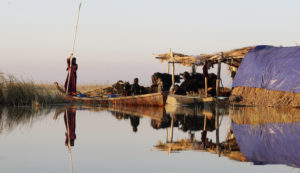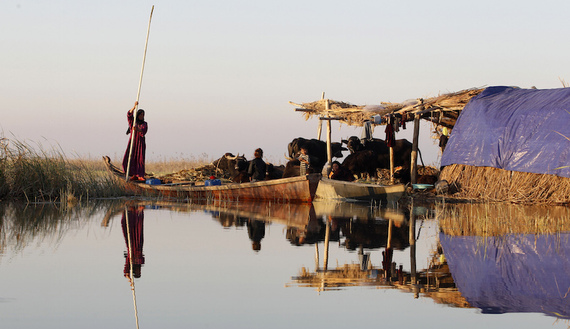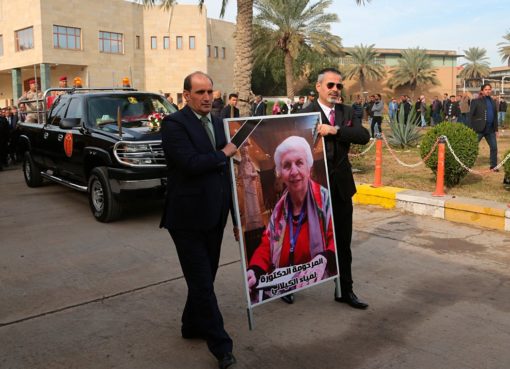
FOR BEST QUALITY IMAGE ALSO SEE: GF10000102221 – RTR3DV63
NASIRIYAH, Iraq — Many houses in the towns and villages in southern Iraq are made of green reeds. The town of Nasiriyah, which is located 350 kilometers (217 miles) southeast of Baghdad, is one of them. The green reeds, found in the marshes of southern Iraq, turn into strong yellow sticks after drying. Green reeds are environmentally friendly, and Iraqis are proud of their cultural value, as they date back to the days of the Sumerian civilization in Iraq in 4000 B.C., specifically in the southern regions of the country. Houses made of papyrus and palm trunks are also common in the south of the country.
Folklore researcher Khayoun Chaker, who lives in the marsh area in Nasiriyah, told Al-Monitor, “Clay inscriptions and cylindrical seals inscribed with the images of houses similar to these [homes] were found in the historical city of Ur near Nasiriyah. This proves that these houses made of reed are the same as those built by the Sumerians thousands of years ago.”
Journalist and Nasiriyah resident Alaa Kouli told Al-Monitor that people buy these houses, which are common in marsh areas such as al-Jabayesh and Hammar Marshes, because “they are cheap and can be built in a few days. They are simple and well suited to the marshes’ environment that has an agricultural aspect with people living off agriculture, fishing and hunting birds.”
Abu Abbas al-Assadi, a sheikh from the Bani Asad tribe in al-Jabayesh district, lives in a house made of reeds in al-Jabayesh, 70 kilometers from the city center of Nasiriyah. The area accommodates floatingvillages on the marshes. Assadi told Al-Monitor, “The raw material from which these houses are built are the plants and large papyrus fields that grow in water. Modern construction materials such as cement and bricks are not used here.”
Assadi said, “This area is still as it was thousands of years ago, and it is home to water, reeds and papyrus. People still hunt for fish in small boats.”
He spoke about the cultural role and status of these houses, saying, “Many of these guesthouses were built of reeds and papyrus plants. The people meet there to discuss political and tribal issues in the presence of prominent figures; social rituals and religious practices are also held there.”
Haider al-Salihi, an expert with 20 years of experience in the construction of reed houses, told Al-Monitor about the building method of such homes. “Reeds and bamboo are dry hollow sticks brought from swamps and marshes that are dried and cut to the desired measurement to be exported to consumers,” he said. “Bamboo sticks are connected by ropes to form six firm columns in the ground, which are considered the basis of the structure. Long, bendable arms are made of these sticks to cover the ceiling and walls, which are connected with ropes. The structure is then covered with carpets made of papyrus plants or palm fronds to give the guesthouse its final shape.”
He added, “Roughly seven people take turns to build the guesthouse. They do not use any industrial machines, except knives to cut the reeds and ropes. But after the completion of the houses, they are furnished by their owners — if they are rich — with satellite dishes, internet, and heating and cooling appliances.”
In Babil province, which is roughly 100 kilometers south of Baghdad, Sheikh Majid Kallabi spoke to Al-Monitor about “the popularity of this method in the construction of houses, despite Babil being far from the marshes where reeds grow.”
He said, “This method of building houses became widespread in the 1980s when the region’s population emigrated to Babil after the marshes were dried out due to the Iran-Iraq War [1980-88], and they brought this new method of construction with them.”
In Babil, Mohamed Hassan, a farmer, gave up his clay house and built a house of reeds, palm fronds and trunks. He told Al-Monitor, “This kind of house is adequate for the hot Iraqi weather because it provides a cool environment due to air currents that come in through the perforated walls of the house. In winter we insulate it well to avoid rain leakage.”
In 1824, military commander George Keppel described these structures as “lined-up yellow houses [across the Tigris River], ranging in length from 50 to 60 feet and resembling the structure of a capsized ship.”
To preserve this heritage in eco-friendly houses, the marsh environment — suffering from limited water resources — needs help. Water issues are pushing people to migrate and killing reeds and papyrus plants that provide the raw materials for the construction of these houses.
Iraq is seeking to include the marshes on the World Heritage List in mid-July at the UNESCO meeting to be held in Turkey, where member states will vote on the inclusion of new sites on the list.
Adel al-Dukheili, the official in charge of trying to get the marshes included on the World Heritage List, told Al-Monitor, “There are exceptional efforts made by the local government and the Nasiriyah provincial council in cooperation with the citizens to achieve this goal, which has political, cultural and economic ends.”
He added, “There is international sympathy for the inclusion of the marshes on the World Heritage List, especially the reed guesthouses in southern Iraq because of their Sumerian cultural and social role.”
For the residents of southern Iraq to maintain their culture of building homes out of reeds and to prevent the people from migrating, national and international support of the residents of the marsh areas is required.
(*)Wassim Bassem is an Iraqi journalist who tracks social phenomena in investigations and reports for various media outlets, including Al-Esbuyia, Bab Nour and Elaph.
TRANSLATOR Pascale Menassa
Source: Al-Monitor Iraq Puls, June 28, 2016
http://www.al-monitor.com/pulse/originals/2016/06/iraq-culture-environment-unesco-heritage.html








Comment here